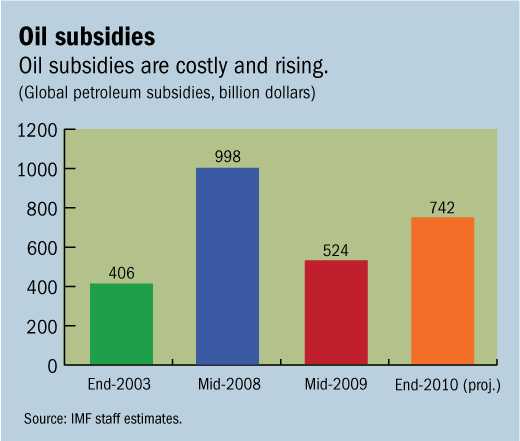
Typical street scene in Santa Ana, El Salvador. (Photo: iStock)
IMF Survey: Petroleum Subsidies on the Rise, Says IMF
May 4, 2010
- Subsidies could reach almost $740 billion by end of 2010
- Mostly benefit higher income households
- Limiting subsidies could help reduce deficits, benefit environment
Petroleum subsidies are costly, inequitable, and rising, and reducing them could have benefits for budgets and the environment, the IMF said in a report.

An oil worker in Kazakhstan: reducing petroleum subsidies could benefit the environment, the IMF said (photo: Maria Golovnina/Reuters)
OIL AND ECONOMICS
Eliminating these subsidies can help reduce the large budget deficits many countries accumulated during the global economic crisis, as well as combat global warming. Some budgetary savings can be redirected to programs to mitigate any adverse impact on the poor.
The paper, “Petroleum Product Subsidies: Costly, Inequitable and Rising,” says to eliminate subsidies, countries will need a new approach to pricing and supporting reforms.
Cost of subsidies is far reaching
A reluctance by many governments to fully pass on increases in international prices to domestic retail prices has resulted in an increase in the cost of petroleum subsidies.
When measuring subsidies, it is preferable to compare the price of petroleum products paid by consumers to a price that fully captures the opportunity cost of using them (for example, any adverse environmental effects). Ideally, these additional costs would be incorporated in the taxes paid on these products.
Such “tax-inclusive” subsidies, as labeled in the IMF study, more than doubled between 2003 and mid 2008, from $400 billion to nearly $1 trillion. Although subsidies fell sharply in the second half of 2008, they started to increase throughout 2009, and are projected to reach about $740 billion by the end of 2010 (see chart).

Many countries have provided fiscal support to help buffer the effects of the global economic crisis and now face rising fiscal deficits. Reducing tax-inclusive subsidies by one-half would decrease the average projected deficit in subsidizing countries by 1 percent of GDP.
Benefits of subsidies mostly go to higher income households
Although subsidies are commonly believed to help the poorest, most of the benefit actually accrues to the highest income households. The benefits of gasoline subsidies are the most regressive, with over 80 percent of total benefits going to the richest 40 percent of households. However, an elimination of these subsidies can still have a sizeable negative impact on poor households, and would need to be replaced with better targeted transfers to the neediest. These types of changes would require well thought out reforms, which could include
• Maintaining subsidies on commodities that are more important in the household budgets of the poor, for example, kerosene
• Expanding the funds available to existing programs that help the poor, including school meals, education and health fees, and other forms of cash transfers
• Improving the design of social safety net programs over time.
Limit subsidies to help the environment
With climate change a serious and growing global risk, the effect of petroleum subsidies on the environment cannot be overlooked. Limiting subsidies could have substantial benefits for the environment by reducing oil consumption and the associated greenhouse gas emissions. Halving tax-inclusive subsidies could reduce these emissions by around 10 percent by 2050.
Reforms needed
A number of additional measures can be implemented to reinforce the reform process and avoid future subsidies. Subsidies should be transparently recorded in government accounts so that they can more explicitly compete with alternative uses of public funds, and public information campaigns should emphasize these trade-offs.
Although a liberalized approach to petroleum pricing is best, countries can adopt an automatic pricing mechanism in the interim while they develop a competitive supply system and an effective regulation capacity. Pricing mechanisms can also be designed to avoid sharp retail price increases in the short term while simultaneously reflecting international price changes over the medium term and managing fiscal volatility.







